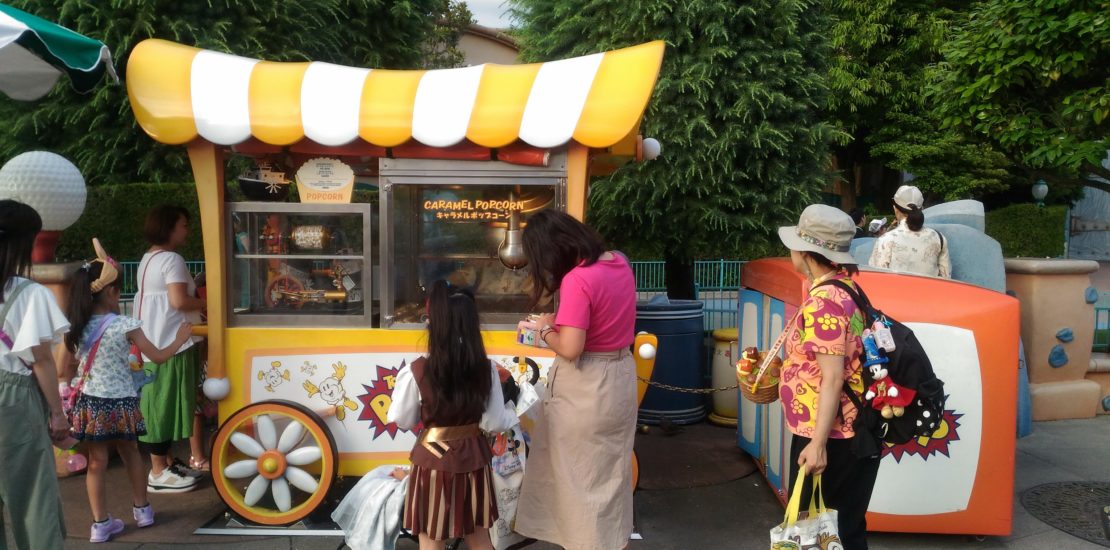
A Quick Guide Part 2: How to live with allergies? Home Cook Edition
Caution: this article addresses non-life-threatening allergies and intolerances and is not meant as a guide for those dealing with life-threatening allergies like celiac disease
In part 1 of A Quick Guide to living with allergies, I shared tips on eating out and shopping at the kombini safely.
But eating out all the time is expensive. If like me, you have limitations due to allergies, you probably want to create a balanced, yummy life in your own kitchen. Is it possible?
The answer is, yes! And it starts with getting ingredients.
GROCERY SHOPPING
I get my groceries from 3 main places. What I can’t find there, I order online, or at markets/specialty shops.
#1 SuperValue, my neighborhood supermarket
#2 Yaoya (local greengrocers)
#3 Kaldi, &Leaf, natural food shops
[Photo of supermarket shelves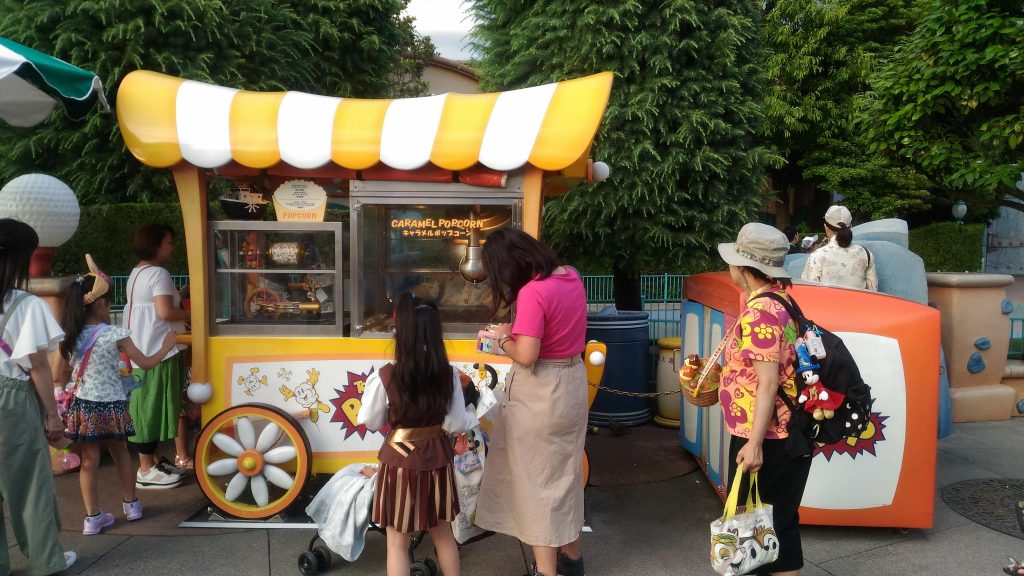
Caption: Time to go shopping!]
Supermarket
Here are some of my staples by food group:
- Carbs: brown and white rice
- Grains: oatmeal
- Starches: sweet potatoes*
- Vitamins: fresh veggies, which needs its own list!
- Carrots
- Cabbage (pre-shredded in a pack, easy cooking!)
- 水菜 mizuna or チンゲン菜 chingensai
- Spring onions, green onion
- Cucumbers
- Broccoli
- Prebiotics: garlic, purple onion
- Calcium: 食べる魚 taberu sakana dried baby sardines; and 鰹節 bonito flakes
- Fats and oils: olive oil, avocados, fish sauce, coconut milk**
- Protein: ぶり trout or 鮭 salmon, 小豆 azuki beans (dried)***
*I avoid spinach, potatoes, and tomatoes, which are likely sprayed with pesticides that could be harmful for people with gut health issues
**I try to avoid canned goods and buy cartons when I can
***For additional bean protein, try the dry goods stalls along Ameyokocho between Ueno and Okachimachi Station
Yaoya
One of the joys of shopping at the yaoya is that what’s in season is what is cheap, so you get natural variety in your menu.
My seasonal faves:
- -sweet corn
- -sweet potatoes
- -red shiso leaf
- –kabocha, or Japanese pumpkin
If your diet allows you to eat fruit, yaoya is a good place to get it fresh and cheap.
Natural Food Shops
Kaldi: walnuts (~650yen for 500g), quinoa, chia seeds*
&Leaf: coconut oil, brown rice pasta
*Flax seeds, which can replace eggs in baking, are called アマニ amani. They are not widely sold in Japan, so I order them on Amazon.
Tip: Pickle and Freeze!
I buy in bulk for the week, so to keep my veggies from going bad, I pickle them in gluten-free vinegar and sea salt or blanch and freeze them to toss in the pot or pan later.
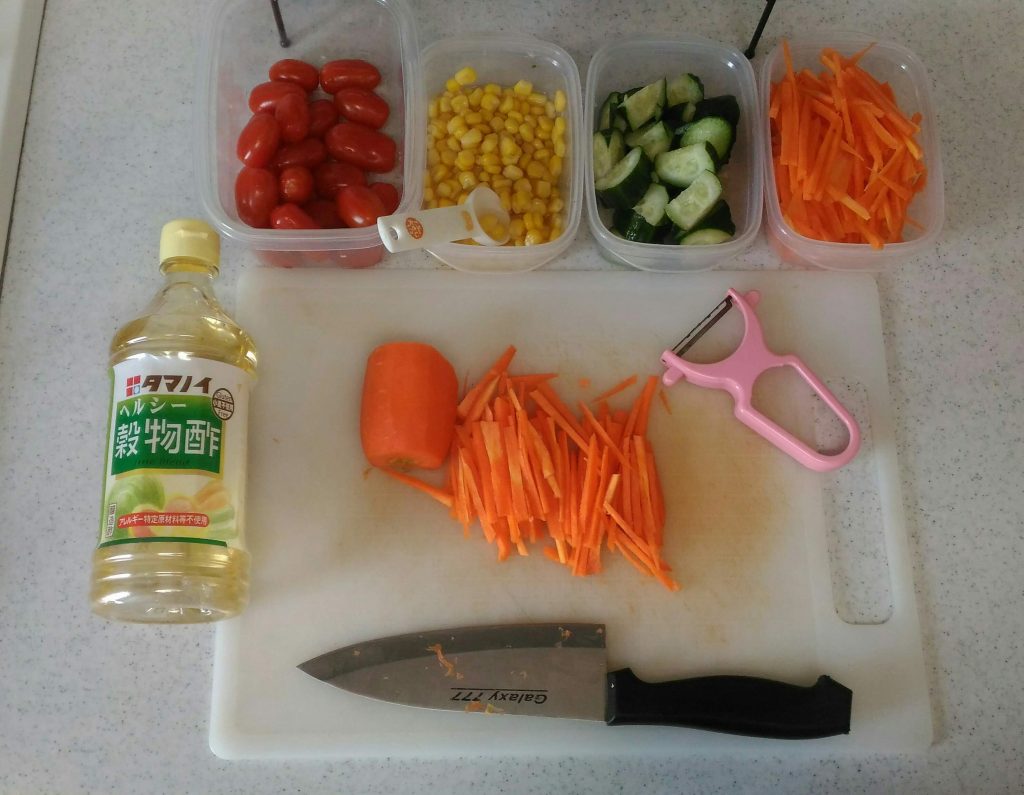
IN THE KITCHEN
So you have a fridge full of ingredients. Now what?
If you are a recipe person, you can search “vegetarian recipe,” “keto recipe,” “_____-free recipe” (insert your allergy) or “paleo recipe” for some good alternative dishes.
For me, basically, I use my carbs and starches as a base. Then, for my main dish I usually fry up some fish (pescatarian meal) or a cup of beans (vegetarian meal) flavored with onion, garlic, and spices. Then I add seasonal vegetables.
In the winter I throw all the vegetables into a pot with garlic, ginger, bay leaf, salt, and olive oil for a simple soup, or alternatively toss my veggies in olive oil and make roasted veggies–super heartwarming (and house-warming)! Gluten-free vinegar and olive oil with dried basil makes for a simple and flavorful dressing for salads!

A DAY IN THE YUMMY LIFE
Here’s one sample day in the yummy life!
Pescatarian Dinner Menu
Pan-fried salmon and sautéed garlic, onions, and leafy veggie (I like 水菜 mizuna or チンゲン菜 chingensai) and rice or gluten-free pasta with a side of steamed かぼちゃ kabocha, or Japanese pumpkin. Kabocha makes a sweet and satisfying side drizzled with coconut oil and sprinkled with toasted and crushed walnuts and cinnamon powder
Photo of a salmon dinner
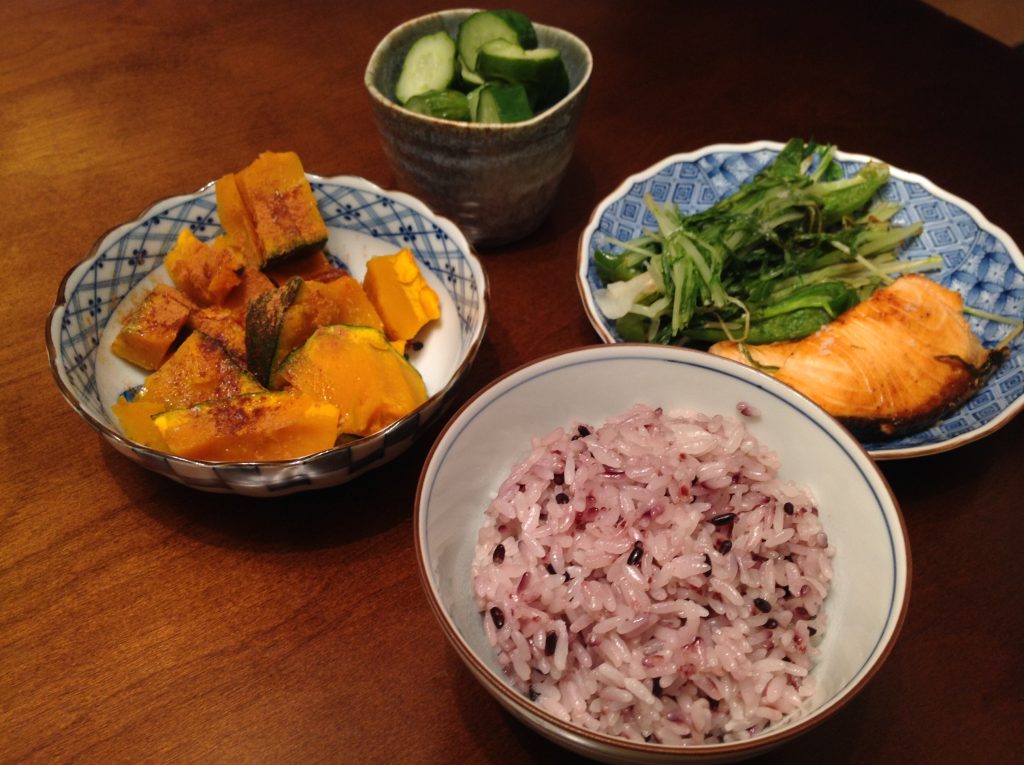
Photo of steamed pumpkin

“Traditional” 和風 Wafū Japanese-Style Breakfast Menu
A bowl of white rice with a juicy umeboshi in the center, a sliver of leftover salmon, and a 4-ingredient salad: cucumber, shredded cabbage, sweet corn, and avocado drizzled with olive oil and gluten-free vinegar.
[Photo of umeboshi rice bowl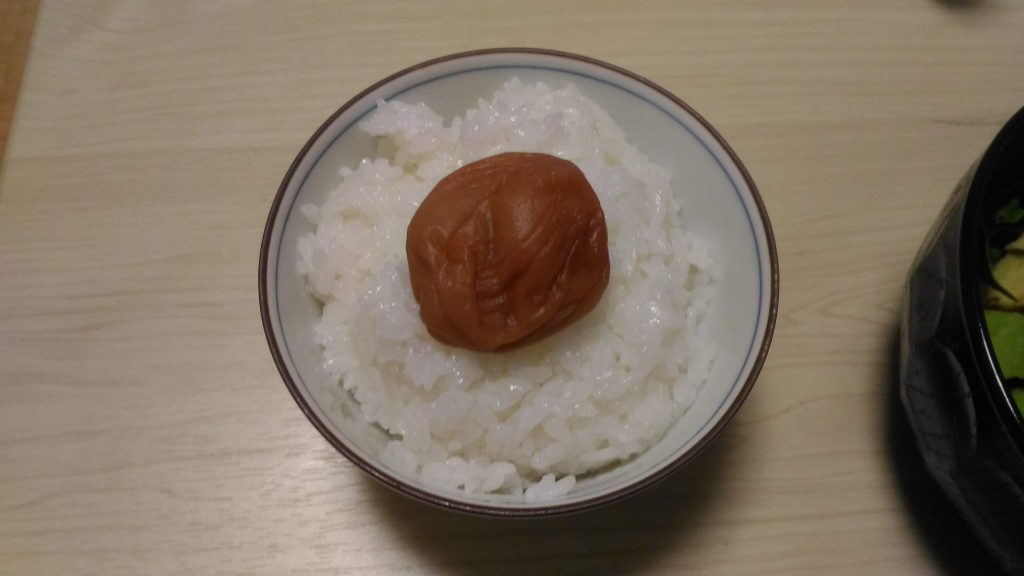
Umeboshi sold at the grocery store typically contains added sugars and sweeteners, so I go to the specialty 梅干し umeboshi store and ask for 昔ながら mukashinagara or old-fashioned umeboshi made from only two ingredients: 梅 Japanese plum and 塩 salt
Lunch Menu
Toasted baby sardines, leek, and chickpeas over a. rice b. a steamed sweet potato, sliced c. oatmeal (cook on the dry side), with a side of sliced avocado and sweet corn
[Photo of toasted sardines and chickpeas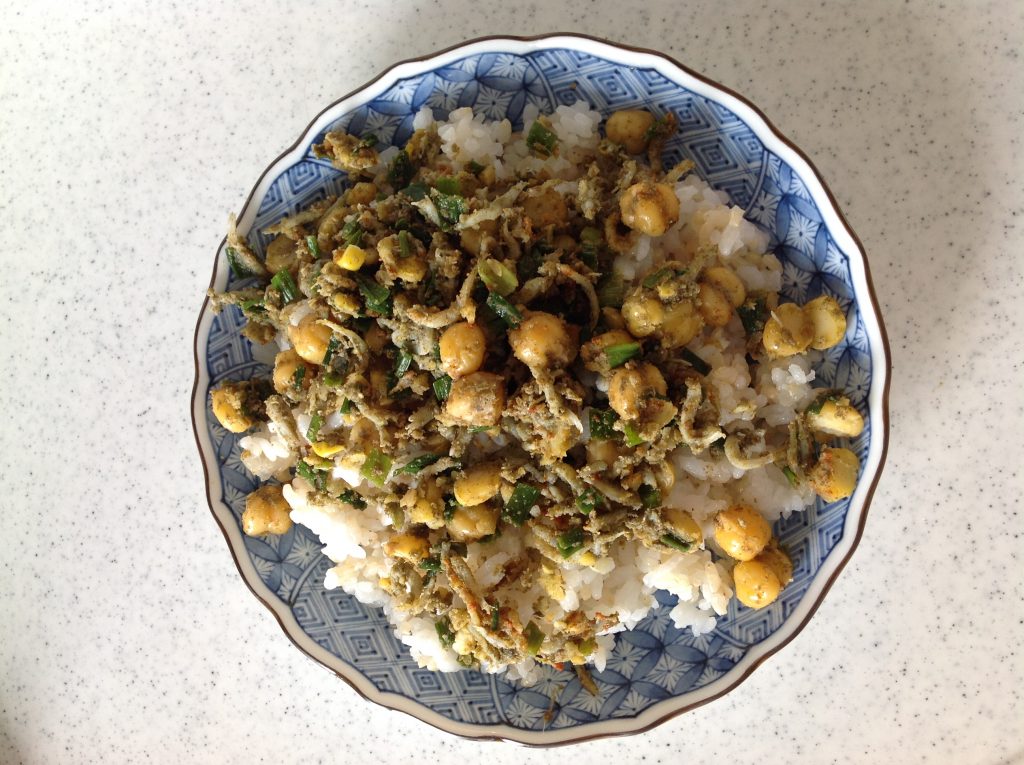
Afternoon Snack
Gluten-free brown rice crackers (natural food store)
[Photo of gluten-free snacks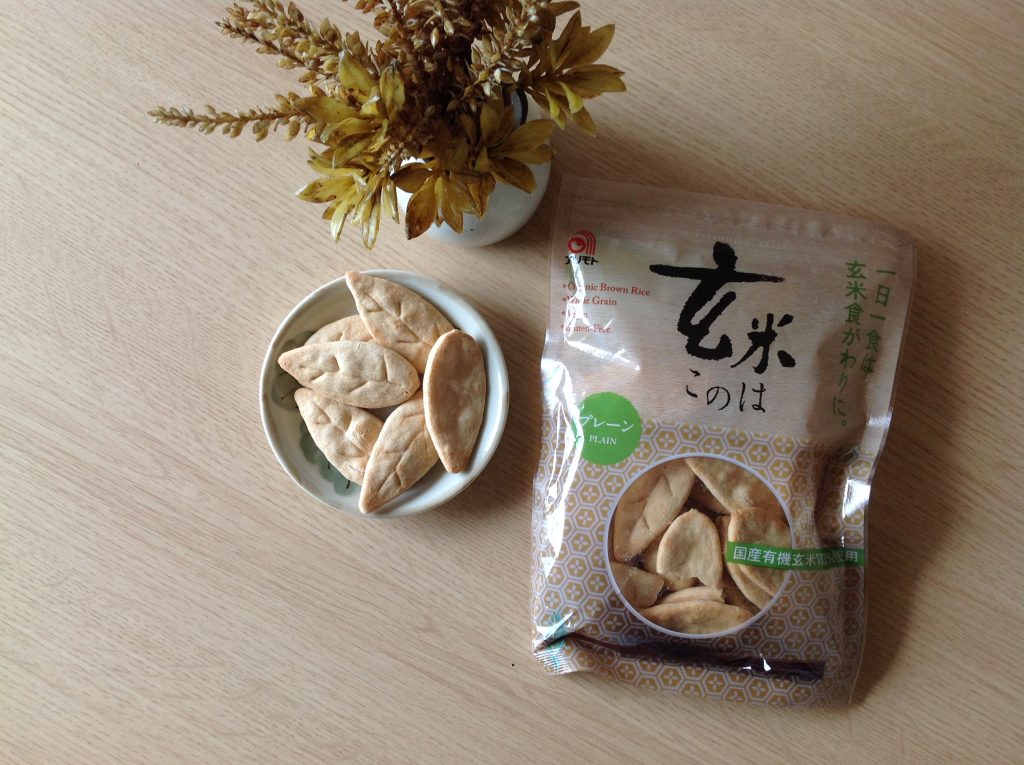
PART II: PACKING YOUR OBENTO

Living in Tokyo, it would be a waste not to go out and enjoy sightseeing. However, unlike most people, lunch is not as simple as popping into a convenience store for a cheap and delicious お弁当 obento. Rather than risking my health or enduring a day-long fast, I try to pack my own lunch!
My Obento
To make a really simple but yummy home-made obento, you need white rice mixed with 鰹節 katsuo-bushi, bonito flakes, and a juicy umeboshi. These three ingredients make for a tasty and filling Japanese-style lunch. Umeboshi is optional, but in my opinion it makes it all the more delicious, plus it is a natural preservative–no need for a heavy ice pack.
Make your obento more fancy by adding a dry side:
- Chestnuts (toaster, 3 minutes; microwave, 20 seconds)
- Walnuts (toaster, 3 minutes or until browned)
- Sweet potato (steamed, sliced, sprinkled with salt and pepper)
- Corn on the cob (boiled or grilled in the fish grill)
Photo of corn (closeup)
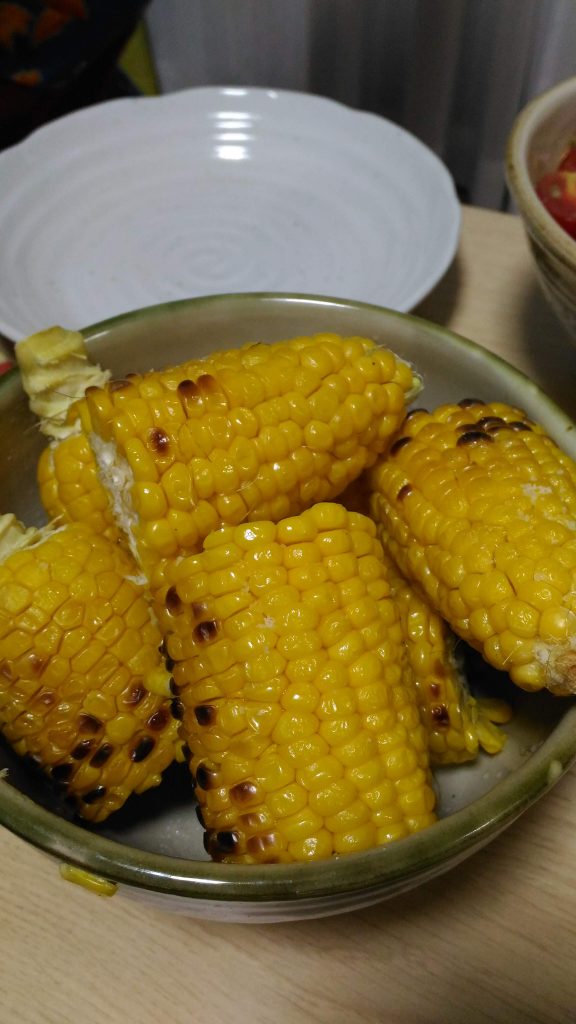
YUMMY LIFE ACHIEVED
So there you have it! It is really simpler than you might think to live a balanced, yummy life with allergies in Japan. Of course, the bigger your budget the more specialized snacks and alternative ingredients you can find, and the more time you have to experiment, to more you will discover.
If you want to go a little further, here are a list of my 10 tips for allergy-free folks:
#1 Replace soy sauce with 魚醤 gyoshō, or fish sauce to make tasty soups, fried rice, or to drizzle on a hot piece of mochi straight out of the toaster (careful, it’s high in sodium!)
#2 Use 塩麹 shiokōji to marinate your meat and fish, especially さば saba, or mackerel (also high in sodium)
#3 Craving Mediterranean? Make homemade hummus with mashed chickpeas + minced garlic + water + salt + roasted red pepper powder
#4 Craving Mexican? Make homemade guacamole with a mashed avocado, gluten-free vinegar, chopped onions, a pinch of salt, and cilantro, if you can procure it (called パクチー pakuchī in Japan)
#5 Fry up savory buckwheat fritters (そば粉 soba-ko) using only buckwheat flour, baking soda, and flaxseed (100g buckwheat flour, ½ tsp baking soda, 1 TBS flaxseed mixed with water until viscous; mix dry ingredients and add water until paint-like in texture–fry with oil)
#6 Make your own maguro-don, tuna rice bowl, with fresh マグロ刺身 maguro sashimi slices and マグロたたき maguro tataki (flavor with fish sauce and wasabi and serve over white rice mixed with gluten-free vinegar!)
#7 Mix 200g white rice + 50g brown rice + 50g quinoa makes for a stomach-friendly, hearty, protein-rich base
#8 Make 白玉団子 shiratama dango with 甘酒 amazake (slowly add ~100g amazake to of 180g 白玉粉 shiratamako until “earlobe softness,” as the Japanese say; roll into balls; toss into boiling water; done whenl they float to the surface)
#9 Try salted coconut ice cream (mix coconut milk from a can with a pinch of sea salt, freeze 2 hours, stirring once or twice) #10 Pickled red onions make a good side. Simply slice and add gluten-free vinegar, sea salt, and a spice of your choice (store in a glass jar and serve with any main dish for some sour pizzazz



